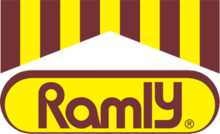Ramly Group
 | |
| Fast food chain | |
| Industry | Frozen and fast food |
| Founded | 1984 in Kuala Lumpur, Malaysia |
| Founders |
Dato' Haji Ramly Mokni (Chairman) Datin' Hajjah Shala Siah Abdul Manap (CEO) |
| Headquarters | SME Industrial Park, Mukim Batu, Kuala Lumpur, Malaysia |
Key people |
Dato' Haji Ramly Mokni Datin Hajjah Shala Siah Abdul Manap Siti Hayu Haji Ramly Mohd Zaharin Haji Ramly Siti Hazura Haji Ramly |
| Products | Mostly fast food such as burger and frozen food like frankfurter, nuggets, meat balls, fried chicken, buns, and sauces like chilli and mayonnaise |
| Owner | Pemasaran Ramly Mokni Sdn Bhd |
| Website |
www |
The Ramly Group is a Malaysian frozen and fast food company founded by Haji Ramly Mokni through Pemasaran Ramly Mokni Sdn Bhd.[1] The company produces burger patties, frankfurter, nuggets, meat balls, fried chicken, buns and sauces like chilli and mayonnaise as well as operates burger stalls widely in Malaysia.
History
The company was founded by Haji Ramly Mokni in 1984, with the aim of developing a clean and good-quality halal Western fast-food chain in Malaysia. Ramly started a business selling burgers with his wife from street food stalls in 1979.[2] While working as a butcher in a market, he discovered that it is unknown whether most fresh-meat sources were halal or not,[3] leading to Ramly's decision to produce a halal-certified meat source for all Muslim consumers in Malaysia.[2]
Expansion
As of 25 August 2015, the company has invested around MYR1 billion to build a factory in the Halal Hub Industrial Park, Indah Island, Selangor,[4][5] with a MYR2 billion revenue target once its factory opens in the latter half of 2017.[6] The Ramly Group currently exports its products to Singapore, Thailand, Indonesia, Myanmar, Cambodia and Bangladesh, and is planning to export its products to other Southeast Asian countries like Vietnam and the Philippines, and is looking into expanding into the Middle Eastern and East Asian markets.[6]
Products
Ramly Burger

Aside from producing burger meat and other frozen foods, the company is also known for its street stalls, which have sold the Ramly Burger in every state in Malaysia since 1979.[3][7][8] The amount and type of burger ingredients can vary greatly depending on location, but usually consist of a beef or chicken patty, margarine, onions, an egg, cabbage, cheese, mayonnaise, soy sauce and various seasonings. The burgers are considered by many to be a local delicacy, especially by city dwellers.[2]
The burger (patties) has been banned in Singapore due to the meat coming from sources which are not on the Agri-Food and Veterinary Authority of Singapore approved list of Commercial Food Imports for Meats which could pose a potential health risk.[9] Singaporean street vendors continue to use the Ramly Burger wrapper.[2][10]
See also
References
- ↑ "Pemasaran Ramly Mokni Sdn Bhd". Ramly. Retrieved 22 March 2016.
- 1 2 3 4 Editions Didier Millet (2009). Malaysia at Random. Editions Didier Millet. pp. 82–. ISBN 978-981-4217-95-8.
- 1 2 Siti Airunnisa Alaui (2 October 2015). "Namanya sinonim dengan burger" (in Malay). Utusan Malaysia. Retrieved 22 March 2016.
- ↑ "Ramly signs deal to set up RM274m factory". Bernama. Malaysian Investment Development Authority. 26 August 2015. Archived from the original on 23 March 2016. Retrieved 22 March 2016.
- ↑ Farhana Joni (26 August 2015). "Kumpulan Ramly melabur RM1 bilion" (in Malay). Utusan Malaysia. Retrieved 22 March 2016.
- 1 2 Aizyzl Azlee (13 January 2016). "Ramly Group eyeing RM2b revenue target with factory opening end-2017". The Malay Mail. Retrieved 22 March 2016.
- ↑ "Chicken Burger and Beef Burger". Ramly. Retrieved 22 March 2016.
- ↑ Tiong Sue Lynn (7 July 2009). "In search of the sloppiest, greasiest and most gratifying burger". The Star. Retrieved 31 October 2014.
- ↑ "Commercial Food Imports".
- ↑ Sheere Ng (2 July 2012). "Do You Know That Ramly Burgers Are Banned In Singapore?". Yahoo! News. Archived from the original on 22 March 2016. Retrieved 22 March 2016.